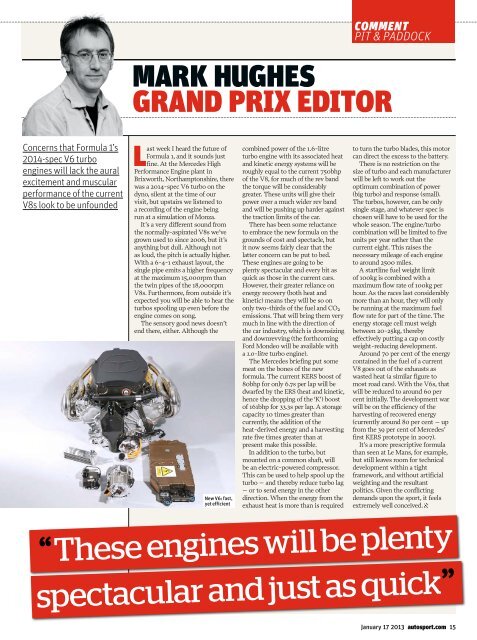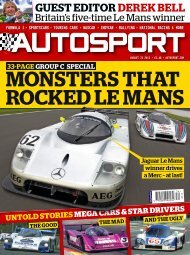in briEF - Mundo Motorizado
in briEF - Mundo Motorizado
in briEF - Mundo Motorizado
Create successful ePaper yourself
Turn your PDF publications into a flip-book with our unique Google optimized e-Paper software.
Concerns that Formula 1’s<br />
2014-spec V6 turbo<br />
eng<strong>in</strong>es will lack the aural<br />
excitement and muscular<br />
performance of the current<br />
V8s look to be unfounded<br />
COMMENT<br />
pit & paddock<br />
Mark HugHes<br />
grand prix editor<br />
Last week I heard the future of<br />
Formula 1, and it sounds just<br />
f<strong>in</strong>e. At the Mercedes High<br />
Performance Eng<strong>in</strong>e plant <strong>in</strong><br />
Brixworth, Northamptonshire, there<br />
was a 2014-spec V6 turbo on the<br />
dyno, silent at the time of our<br />
visit, but upstairs we listened to<br />
a record<strong>in</strong>g of the eng<strong>in</strong>e be<strong>in</strong>g<br />
run at a simulation of Monza.<br />
It’s a very different sound from<br />
the normally-aspirated V8s we’ve<br />
grown used to s<strong>in</strong>ce 2006, but it’s<br />
anyth<strong>in</strong>g but dull. Although not<br />
as loud, the pitch is actually higher.<br />
With a 6-4-1 exhaust layout, the<br />
s<strong>in</strong>gle pipe emits a higher frequency<br />
at the maximum 15,000rpm than<br />
the tw<strong>in</strong> pipes of the 18,000rpm<br />
V8s. Furthermore, from outside it’s<br />
expected you will be able to hear the<br />
turbos spool<strong>in</strong>g up even before the<br />
eng<strong>in</strong>e comes on song.<br />
The sensory good news doesn’t<br />
end there, either. Although the<br />
New V6: fast,<br />
yet efficient<br />
comb<strong>in</strong>ed power of the 1.6-litre<br />
turbo eng<strong>in</strong>e with its associated heat<br />
and k<strong>in</strong>etic energy systems will be<br />
roughly equal to the current 750bhp<br />
of the V8, for much of the rev band<br />
the torque will be considerably<br />
greater. These units will give their<br />
power over a much wider rev band<br />
and will be push<strong>in</strong>g up harder aga<strong>in</strong>st<br />
the traction limits of the car.<br />
There has been some reluctance<br />
to embrace the new formula on the<br />
grounds of cost and spectacle, but<br />
it now seems fairly clear that the<br />
latter concern can be put to bed.<br />
These eng<strong>in</strong>es are go<strong>in</strong>g to be<br />
plenty spectacular and every bit as<br />
quick as those <strong>in</strong> the current cars.<br />
However, their greater reliance on<br />
energy recovery (both heat and<br />
k<strong>in</strong>etic) means they will be so on<br />
only two-thirds of the fuel and CO2<br />
emissions. That will br<strong>in</strong>g them very<br />
much <strong>in</strong> l<strong>in</strong>e with the direction of<br />
the car <strong>in</strong>dustry, which is downsiz<strong>in</strong>g<br />
and downrevv<strong>in</strong>g (the forthcom<strong>in</strong>g<br />
Ford Mondeo will be available with<br />
a 1.0-litre turbo eng<strong>in</strong>e).<br />
The Mercedes brief<strong>in</strong>g put some<br />
meat on the bones of the new<br />
formula. The current KERS boost of<br />
80bhp for only 6.7s per lap will be<br />
dwarfed by the ERS (heat and k<strong>in</strong>etic,<br />
hence the dropp<strong>in</strong>g of the ‘K’) boost<br />
of 161bhp for 33.3s per lap. A storage<br />
capacity 10 times greater than<br />
currently, the addition of the<br />
heat-derived energy and a harvest<strong>in</strong>g<br />
rate five times greater than at<br />
present make this possible.<br />
In addition to the turbo, but<br />
mounted on a common shaft, will<br />
be an electric-powered compressor.<br />
This can be used to help spool up the<br />
turbo – and thereby reduce turbo lag<br />
– or to send energy <strong>in</strong> the other<br />
direction. When the energy from the<br />
exhaust heat is more than is required<br />
to turn the turbo blades, this motor<br />
can direct the excess to the battery.<br />
There is no restriction on the<br />
size of turbo and each manufacturer<br />
will be left to work out the<br />
optimum comb<strong>in</strong>ation of power<br />
(big turbo) and response (small).<br />
The turbos, however, can be only<br />
s<strong>in</strong>gle stage, and whatever spec is<br />
chosen will have to be used for the<br />
whole season. The eng<strong>in</strong>e/turbo<br />
comb<strong>in</strong>ation will be limited to five<br />
units per year rather than the<br />
current eight. This raises the<br />
necessary mileage of each eng<strong>in</strong>e<br />
to around 2500 miles.<br />
A startl<strong>in</strong>e fuel weight limit<br />
of 100kg is comb<strong>in</strong>ed with a<br />
maximum flow rate of 100kg per<br />
hour. As the races last considerably<br />
more than an hour, they will only<br />
be runn<strong>in</strong>g at the maximum fuel<br />
flow rate for part of the time. The<br />
energy storage cell must weigh<br />
between 20-25kg, thereby<br />
effectively putt<strong>in</strong>g a cap on costly<br />
weight-reduc<strong>in</strong>g development.<br />
Around 70 per cent of the energy<br />
conta<strong>in</strong>ed <strong>in</strong> the fuel of a current<br />
V8 goes out of the exhausts as<br />
wasted heat (a similar figure to<br />
most road cars). With the V6s, that<br />
will be reduced to around 60 per<br />
cent <strong>in</strong>itially. The development war<br />
will be on the efficiency of the<br />
harvest<strong>in</strong>g of recovered energy<br />
(currently around 80 per cent – up<br />
from the 39 per cent of Mercedes’<br />
first KERS prototype <strong>in</strong> 2007).<br />
It’s a more prescriptive formula<br />
than seen at Le Mans, for example,<br />
but still leaves room for technical<br />
development with<strong>in</strong> a tight<br />
framework, and without artificial<br />
weight<strong>in</strong>g and the resultant<br />
politics. Given the conflict<strong>in</strong>g<br />
demands upon the sport, it feels<br />
extremely well conceived.<br />
‘‘These eng<strong>in</strong>es will be plenty<br />
spectacular and just as quick’’<br />
January 17 2013 autosport.com 15













